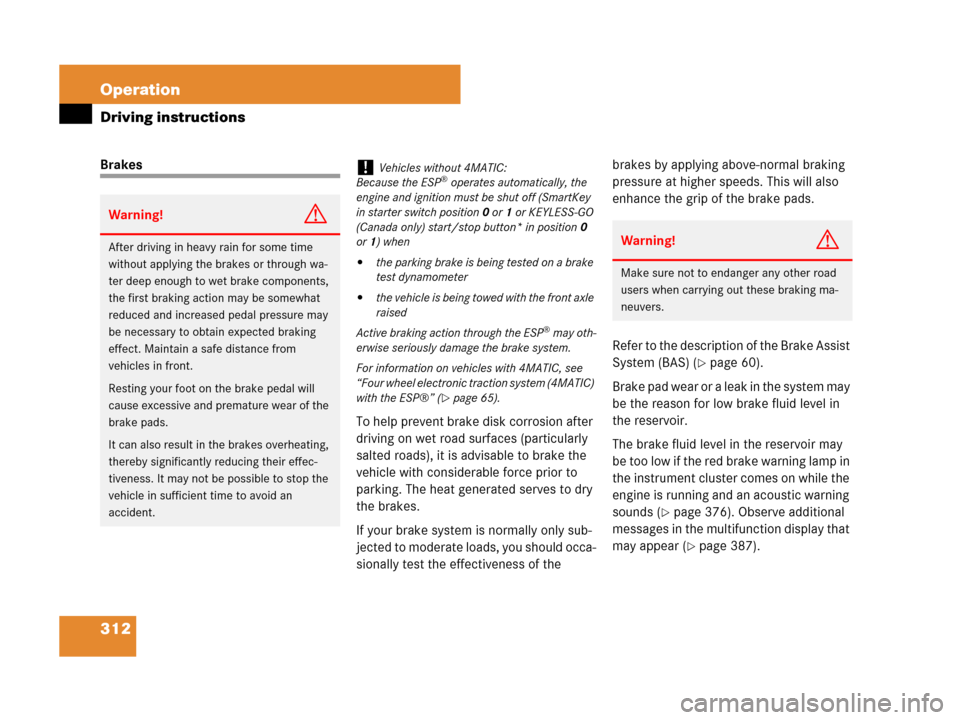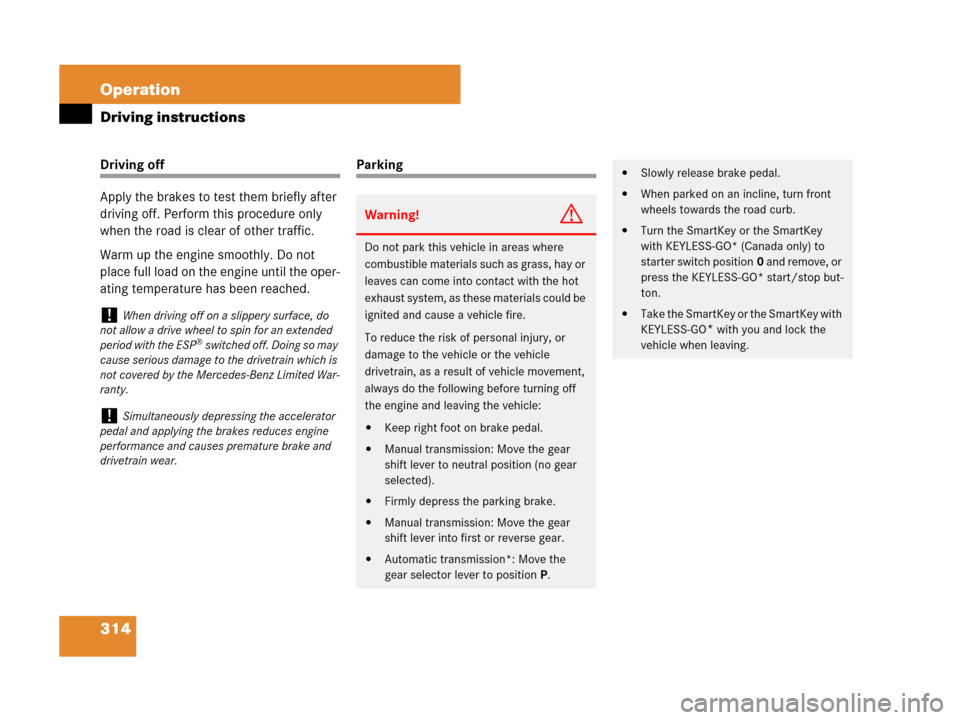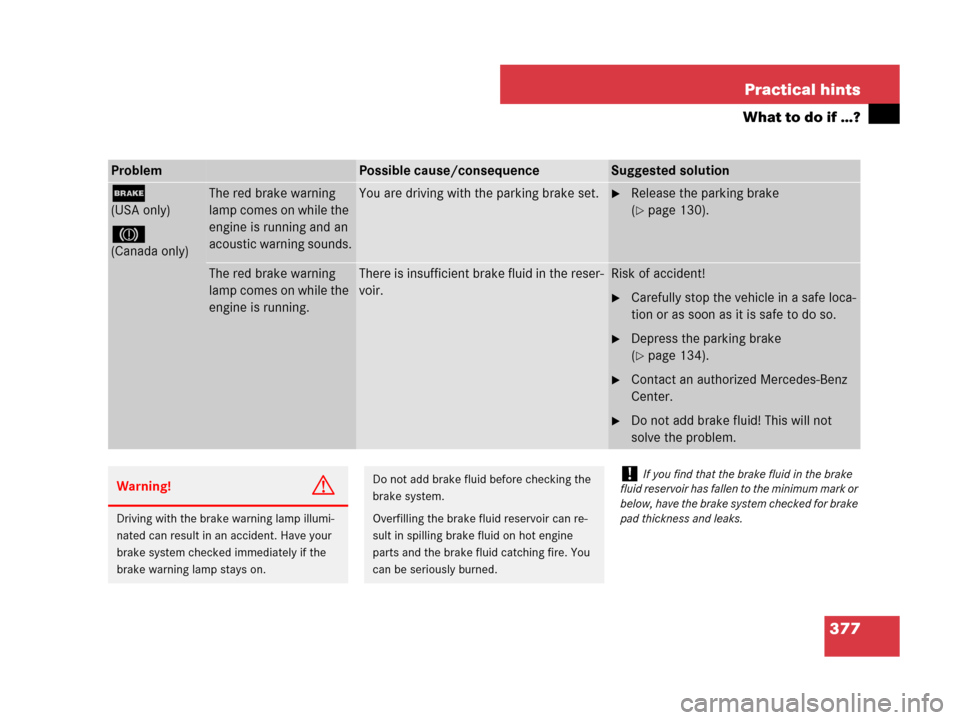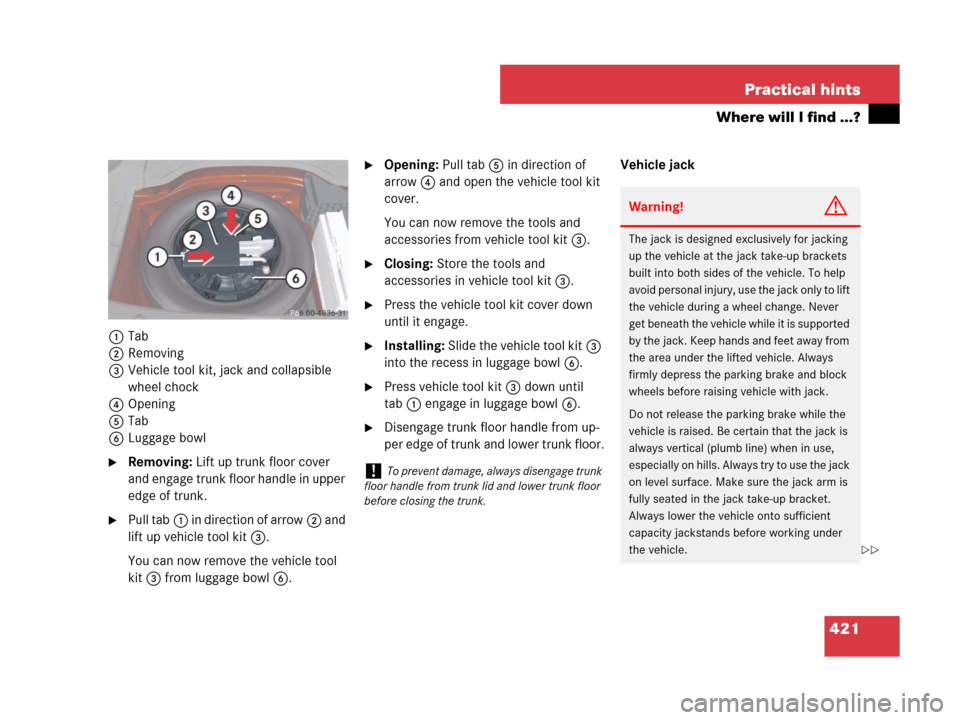Page 313 of 509

312 Operation
Driving instructions
Brakes
To help prevent brake disk corrosion after
driving on wet road surfaces (particularly
salted roads), it is advisable to brake the
vehicle with considerable force prior to
parking. The heat generated serves to dry
the brakes.
If your brake system is normally only sub-
jected to moderate loads, you should occa-
sionally test the effectiveness of the brakes by applying above-normal braking
pressure at higher speeds. This will also
enhance the grip of the brake pads.
Refer to the description of the Brake Assist
System (BAS) (
�page 60).
Brake pad wear or a leak in the system may
be the reason for low brake fluid level in
the reservoir.
The brake fluid level in the reservoir may
be too low if the red brake warning lamp in
the instrument cluster comes on while the
engine is running and an acoustic warning
sounds (
�page 376). Observe additional
messages in the multifunction display that
may appear (
�page 387).
Warning!G
After driving in heavy rain for some time
without applying the brakes or through wa-
ter deep enough to wet brake components,
the first braking action may be somewhat
reduced and increased pedal pressure may
be necessary to obtain expected braking
effect. Maintain a safe distance from
vehicles in front.
Resting your foot on the brake pedal will
cause excessive and premature wear of the
brake pads.
It can also result in the brakes overheating,
thereby significantly reducing their effec-
tiveness. It may not be possible to stop the
vehicle in sufficient time to avoid an
accident.
!Vehicles without 4MATIC:
Because the ESP® operates automatically, the
engine and ignition must be shut off (SmartKey
in starter switch position0 or1 or KEYLESS-GO
(Canada only) start/stop button* in position0
or1) when
�the parking brake is being tested on a brake
test dynamometer
�the vehicle is being towed with the front axle
raised
Active braking action through the ESP
® may oth-
erwise seriously damage the brake system.
For information on vehicles with 4MATIC, see
“Four wheel electronic traction system (4MATIC)
with the ESP®” (
�page 65).
Warning!G
Make sure not to endanger any other road
users when carrying out these braking ma-
neuvers.
Page 315 of 509

314 Operation
Driving instructions
Driving off
Apply the brakes to test them briefly after
driving off. Perform this procedure only
when the road is clear of other traffic.
Warm up the engine smoothly. Do not
place full load on the engine until the oper-
ating temperature has been reached.Parking
!When driving off on a slippery surface, do
not allow a drive wheel to spin for an extended
period with the ESP
® switched off. Doing so may
cause serious damage to the drivetrain which is
not covered by the Mercedes-Benz Limited War-
ranty.
!Simultaneously depressing the accelerator
pedal and applying the brakes reduces engine
performance and causes premature brake and
drivetrain wear.
Warning!G
Do not park this vehicle in areas where
combustible materials such as grass, hay or
leaves can come into contact with the hot
exhaust system, as these materials could be
ignited and cause a vehicle fire.
To reduce the risk of personal injury, or
damage to the vehicle or the vehicle
drivetrain, as a result of vehicle movement,
always do the following before turning off
the engine and leaving the vehicle:
�Keep right foot on brake pedal.
�Manual transmission: Move the gear
shift lever to neutral position (no gear
selected).
�Firmly depress the parking brake.
�Manual transmission: Move the gear
shift lever into first or reverse gear.
�Automatic transmission*: Move the
gear selector lever to positionP.
�Slowly release brake pedal.
�When parked on an incline, turn front
wheels towards the road curb.
�Turn the SmartKey or the SmartKey
with KEYLESS-GO* (Canada only) to
starter switch position0 and remove, or
press the KEYLESS-GO* start/stop but-
ton.
�Take the SmartKey or the SmartKey with
KEYLESS-GO
* with you and lock the
vehicle when leaving.
Page 378 of 509

377 Practical hints
What to do if …?
ProblemPossible cause/consequenceSuggested solution
;
(USA only)
3
(Canada only)
The red brake warning
lamp comes on while the
engine is running and an
acoustic warning sounds.You are driving with the parking brake set.�Release the parking brake
(
�page 130).
The red brake warning
lamp comes on while the
engine is running.There is insufficient brake fluid in the reser-
voir.Risk of accident!
�Carefully stop the vehicle in a safe loca-
tion or as soon as it is safe to do so.
�Depress the parking brake
(
�page 134).
�Contact an authorized Mercedes-Benz
Center.
�Do not add brake fluid! This will not
solve the problem.
Warning!G
Driving with the brake warning lamp illumi-
nated can result in an accident. Have your
brake system checked immediately if the
brake warning lamp stays on.
Do not add brake fluid before checking the
brake system.
Overfilling the brake fluid reservoir can re-
sult in spilling brake fluid on hot engine
parts and the brake fluid catching fire. You
can be seriously burned.!If you find that the brake fluid in the brake
fluid reservoir has fallen to the minimum mark or
below, have the brake system checked for brake
pad thickness and leaks.
Page 379 of 509

378 Practical hints
What to do if …?
ProblemPossible cause/consequenceSuggested solution
±The yellow engine malfunc-
tion indicator lamp comes
on while driving.There is a malfunction in:
�The fuel management system
�The ignition system
�The emission control system
�Systems which affect emissions
Such malfunctions may result in excessive
emissions values and may switch the en-
gine to its limp-home (emergency opera-
tion) mode.
�Have the vehicle checked as soon as
possible at an authorized
Mercedes-Benz Center.
An on-board diagnostic connector is
used by the service station to link the
vehicle to the shop diagnostics system.
It allows the accurate identification of
system malfunctions through the read-
out of diagnostic trouble codes. It is lo-
cated in the front left area of the
footwell next to the parking brake pedal.
iIn some states you may be required by law
to have the vehicle serviced as soon as the
engine malfunction indicator lamp comes on.
Check local requirements.
Page 401 of 509
400 Practical hints
What to do if …?
Display Possible cause/consequencePossible solution
;Check
Brake Fluid LevelThere is insufficient brake fluid in the reser-
voir.Risk of accident!
�Carefully stop the vehicle in a safe location or
as soon as it is safe to do so.
�Depress the parking brake (�page 134).
�Contact an authorized Mercedes-Benz Cen-
ter.
�Do not add brake fluid! This will not solve the
problem.
(USA only)
3
(Canada only)
Warning!G
Driving with the message Check Brake
Fluid Level
displayed can result in an ac-
cident. Have your brake system checked im-
mediately. Do not add brake fluid before
checking the brake system. Overfilling the
brake fluid reservoir can result in spilling
brake fluid on hot engine parts and the
brake fluid catching fire. You can be serious-
ly burned.
!If you find that the brake fluid in the brake
fluid reservoir has fallen to the minimum mark or
below, have the brake system checked for brake
pad thickness and leaks.
Page 402 of 509
401 Practical hints
What to do if …?
Display Possible cause/consequencePossible solution
;ReleaseYou are driving with the parking brake set.�Release the parking brake (�page 130).
(USA only)Parking Brake
!
(Canada only)
;
(USA only)
3
EBR, ABS, and ESP
Inoperative
See Operator’s Manu-
alEBP, ABS and ESP® are switched off due to
a malfunction. BAS and the hill start assist
are also switched off.
The brake system still functions normally
but without the ABS and ESP
® available.
�Continue driving with added caution.
Wheels may lock during hard braking, re-
ducing steering capability.
�Have the system checked at an authorized
Mercedes-Benz Center as soon as possible.
Failure to follow these instructions increases
the risk of an accident.
(Canada only)
Page 422 of 509

421 Practical hints
Where will I find ...?
1Tab
2Removing
3Vehicle tool kit, jack and collapsible
wheel chock
4 Opening
5Tab
6Luggage bowl
�Removing: Lift up trunk floor cover
and engage trunk floor handle in upper
edge of trunk.
�Pull tab1 in direction of arrow2 and
lift up vehicle tool kit3.
You can now remove the vehicle tool
kit3 from luggage bowl6.
�Opening: Pull tab5 in direction of
arrow4 and open the vehicle tool kit
cover.
You can now remove the tools and
accessories from vehicle tool kit3.
�Closing: Store the tools and
accessories in vehicle tool kit3.
�Press the vehicle tool kit cover down
until it engage.
�Installing: Slide the vehicle tool kit3
into the recess in luggage bowl6.
�Press vehicle tool kit3 down until
tab1 engage in luggage bowl6.
�Disengage trunk floor handle from up-
per edge of trunk and lower trunk floor.Vehicle jack
!To prevent damage, always disengage trunk
floor handle from trunk lid and lower trunk floor
before closing the trunk.
Warning!G
The jack is designed exclusively for jacking
up the vehicle at the jack take-up brackets
built into both sides of the vehicle. To help
avoid personal injury, use the jack only to lift
the vehicle during a wheel change. Never
get beneath the vehicle while it is supported
by the jack. Keep hands and feet away from
the area under the lifted vehicle. Always
firmly depress the parking brake and block
wheels before raising vehicle with jack.
Do not release the parking brake while the
vehicle is raised. Be certain that the jack is
always vertical (plumb line) when in use,
especially on hills. Always try to use the jack
on level surface. Make sure the jack arm is
fully seated in the jack take-up bracket.
Always lower the vehicle onto sufficient
capacity jackstands before working under
the vehicle.
��
Page 427 of 509
426 Practical hints
Unlocking/locking in an emergency
Fuel filler flap
�Open the fuse box in the trunk
(
�page 458).
1Release cable
�Pull on the release cable1.
�Open the fuel filler flap.Manually unlocking the transmission
gear selector lever
In case of power failure, the transmission
gear selector lever can be manually un-
locked, e.g. to tow the vehicle.
1Selector lever cover
2Unlocking mechanism
�Apply the parking brake firmly.
�Push the selector lever cover1 to the
left and pull it up and off.
�Push the unlocking mechanism2
down and move the selector lever out
of positionP at the same time.The selector lever can now move freely
until reset to positionP.
iThis procedure does not arm the anti-theft
alarm system nor does it lock the fuel filler flap.
iThe gear selector lever is locked again when
moving it to positionP.
��